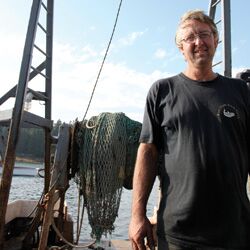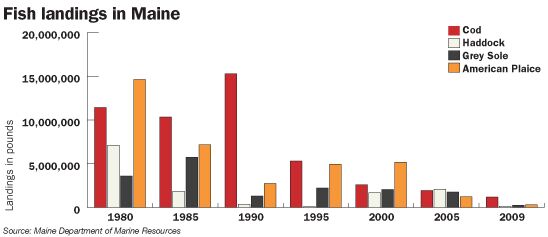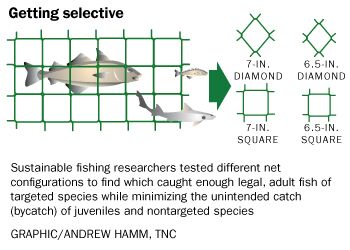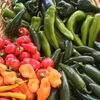Tipping the scales | Maine takes the lead in a conservation program aimed at changing the fishing industry one boat at a time
Though it’s better known for its conservation work on land, a few years ago The Nature Conservancy decided to try something new. In collaboration with the Island Institute and the Penobscot East Resource Center, the conservancy bought two commercial fishing permits. The organization, the wealthiest conservation group in the country, wasn’t getting into the fishing business — it was looking to change the fishing industry from the inside out.
That was in 2009, and since then the organization has worked with five Maine fishermen to develop more sustainable fishing methods and gear, such as nets with larger mesh that reduce bycatch, to help depleted fish stocks rebound and preserve what’s left of Maine’s fishing industry.
The Nature Conservancy and its partners lease out the permits to fishermen at a discount, as long as they agree to test more sustainable fishing gear and report back on where they find fish. “We’re always looking for new ideas, and a strong partnership with fishermen is really critical,” says Geoff Smith, marine program director at The Nature Conservancy in Maine. “They understand how gear works better than I or anyone at The Nature Conservancy does … It’s been a really positive relationship.”
So positive, in fact, that The Nature Conservancy in Maine is in the midst of raising $1.3 million to purchase as many as five more commercial fishing permits, which can run anywhere from $50,000 to $500,000 depending on factors such as the catch history associated with them. The permits would form the core of a permit bank, which, like a community land trust, would be managed by a group of fishermen and other stakeholders. The group has already raised $600,000 toward that goal, according to Mike Tetreault, executive director of The Nature Conservancy in Maine.
Though sustainable fisheries is a global issue and The Nature Conservancy is one of the largest conservation nonprofits in the world, Maine is playing an outsized role in the conservancy’s efforts, M.A. Sanjayan, lead scientist for The Nature Conservancy, says during a recent visit to Maine. He believes it’s because Mainers are forced to think creatively about an industry so deeply tied to the state’s heritage and peoples’ livelihoods. The Nature Conservancy has also purchased fishing permits in central California and is working with fishermen there.
The permit program is a change in tactics, Sanjayan says. In the past, environmental groups tackled problems in the fishing industry by either boycotting products or pushing stricter regulations. “But they missed the middle ground with the fishermen,” he says. “And that’s what we’re doing here.”
Fishing woes
Trace your finger along a map of the Maine coast, starting at Kittery and heading Down East. You’ll pass Wells, Portland and Harpswell, Cundy’s Harbor, Friendship and then Port Clyde, which lies less than halfway to Eastport. But as you pass Port Clyde, a traditional Maine industry starts to disappear. From Rockland to Lubec, not a single working commercial groundfishing vessel remains.
In the mid-1990s, Maine boasted roughly 350 active vessels fishing for groundfish, which include such seafood restaurant staples as cod, haddock and flounder. This past year, 70 vessels were still fishing, according to Smith at The Nature Conservancy in Maine. Total groundfish landings in Maine have dropped from a high of 44.8 million pounds worth approximately $33 million in 1991 to 6.6 million pounds valued at about $6.2 million in 2009, according to the Maine Department of Marine Resources.
Gary Libby, a fisherman from Port Clyde who has collaborated with The Nature Conservancy to promote sustainable fishing gear, has worked on draggers for 34 years. The last really good years of fishing he remembers before stocks started to decline were 1992 and 1993. They haven’t been the same since. A few years ago, a dozen vessels fished out of Port Clyde, he says. Last year, there were five or six. “I think it’s been as poor as it’s been in my 30-odd years of fishing,” says Libby, now 52 years old. “It’s pretty tough sledding right now.”
But Libby is encouraged by the efforts of The Nature Conservancy and the idea of a permit bank, which would basically allow fishermen to lease additional fish above their individual catch limits at a discount by using sustainable practices. Libby leased about 1,000 pounds of fish from The Nature Conservancy last summer, which helped him stay in business. “The more availability [of permits] to the fishermen like me that we have like that, whether it be The Nature Conservancy or a state permit bank, is beneficial to small operators,” he says. “Guys like me rely on people like The Nature Conservancy to help us out by doing this, buying those permits, having those fish available, trying to keep us afloat until we get fish stocks rebuilt. It’s keeping the little guy in the game.”
If a permit bank is created, a group of fishermen and stakeholders would manage it, rather than being solely controlled by The Nature Conservancy, says Tetreault. “Over time, as fishermen co-create cleaner ways to fish, they may institutionalize some practices they’d like to see being done differently,” he says, suggesting that this could one day become the major use of permits held in the bank. “And so the fishermen will have a hand in having us shape what are the conditions by which people would need to use the permits. So they can be available to members of the community who are up against their catch limits, but also available to [those who]experiment with new practices.”
Developing and testing more sustainable gear is another goal of the project. The conservancy, along with the Gulf of Maine Research Institute, has been testing nets with larger-size mesh that catches marketable fish but allows small fish to escape, and lighter, stronger nets that reduce drag and therefore reduce fuel consumption.
The results have been positive. Last year, Libby used 7-inch mesh instead of 6.5-inch mesh, and got at least an extra $1 per pound for his fish because they were of higher quality, though his volume fell since the larger mesh allowed more smaller fish to escape. His fish were considered higher quality for two reasons: If a fisherman reduces the amount of fish he brings up in his net, the caught fish are buried under less weight and therefore less beaten and bruised as they come up and get dropped on the ship’s deck. Also, the less bycatch he has to sort through and throw overboard, the less time it takes to get the commercially viable fish onto ice.
Libby’s not sure if he came out on top, but as long as he’s making a living, he says a more sustainable model makes sense to him. Smith at The Nature Conservancy hopes such a model will prevail, helped along by the real-world results of more sustainable gear. “We’re confident if we develop better gear and fishermen ... see a difference in the performance in a research setting, the gear will speak for itself and more fishermen will want to use it.”
Libby hopes so, too, for the sake of Maine’s fishing industry. “It’d be better if there was more fish available for everybody, but I’m looking down the road for that hopefully,” he says. “If we still don’t rebuild stocks even after all this, then that will be a failure. But I don’t know what system would really bring the fish back except putting a lot of people out of business.”
Whit Richardson, a writer based in Yarmouth, can be reached at editorial@mainebiz.biz.













Comments